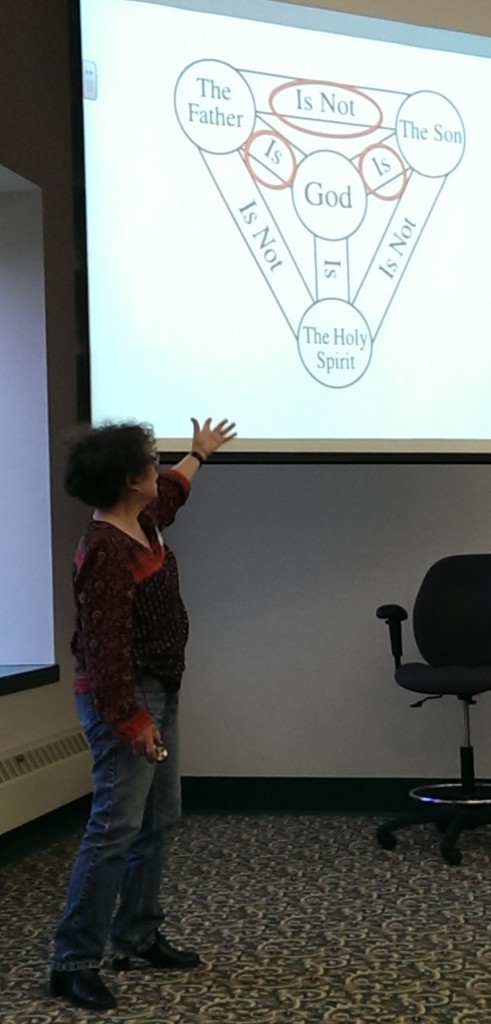 “I’ve heard of John and Peter, and James – but who is this Cephas?”
“I’ve heard of John and Peter, and James – but who is this Cephas?”
A more informed Bible reader will tell him that Cephas is Peter. The point is not that Cephas is like Peter, or similar to Peter, but rather that Cephas just is Peter – they are the same man. They are numerically the same man.
In the sort of logic which is standardly taught in introductory courses, one analyzes the claim “Cephas and Peter are the same man” as a conjunction of three claims:
- Cephas is a man, and
- Peter is a man, and
- Cephas just is Peter.
Standardly, then, relative identity statements are understood in terms of absolute, or non-relative identity statements.
But not all philosophers agree. The famous logician Peter Geach (1916-2013) thought that absolute statements are meaningless – that it makes no sense to ask whether or not Cephas and Peter are the same (full stop). We can, however, ask whether or not they’re the same man, apostle, brother, animal, citizen, etc. So for Peter Geach, relative identity statements are basic, and can’t be broken down into the three components we just explained, because, he thought, the third component was meaningless.
This opens up the question whether or not some a and b could be the same F, but different Gs. Could, for instance, Cephas and Peter be the same man, but different apostles, or different husbands, or different citizens? It would seem not. In fact, there has been no uncontroversial case of some a and b being the same something, but different somethings elses. While various metaphysical puzzles have moved a few philosophers to posit such cases, in each case a majority of philosophers thinks that the puzzle in question has a better solution. Still, the matter remains controversial, and in today’s episode, you’ll hear an accomplished philosopher suggest another non-theological case of being the same F but different Gs – one having to do with air travel.
The most important puzzle-case motivating this non-standard view relative identity is that of the Trinity. Peter Geach thought that the traditional Trinity claims will only be self-consistent if relative identity is basic, not analyzable as above. Here, the Father and Son will be the same God, but different divine Persons. And since the threefold analysis of relative identity statements is rejected, it won’t follow that the Father just is the Son.
 In today’s episode, we hear a presentation from the 2014 SCP meeting at Niagara University, in Niagara New York. This conference was dedicated to the work of distinguished Christian philosopher Dr. Peter van Inwagen, of the University of Notre Dame.
In today’s episode, we hear a presentation from the 2014 SCP meeting at Niagara University, in Niagara New York. This conference was dedicated to the work of distinguished Christian philosopher Dr. Peter van Inwagen, of the University of Notre Dame.
Our presenter is Dr. Harriet Baber, a professor of phil at the University of San Diego. Her presentation is “Relative Identity Redux.” In it, she criticizes some work on this topic by Dr. Michael C. Rea. This episode includes the discussion period, in which she fields some interesting questions from Dr. van Inwagen and others.
I recommend that you watch the youtube version of this talk, because it includes Dr. Baber’s helpful and entertaining powerpoint slides, which will help you to follow her points, especially if you’re not a professional philosopher. (There are also other visual elements added by me, mostly for clarity.)
You can also listen to this episode on stitcher or itunes (please subscribe and rate us in either or both). If you would like to upload audio feedback for possible inclusion in a future episode of this podcast, put the audio file here.
Links for this episode:
- Dr. Harriet Baber’s homepage
- her University of San Diego page
- her writings at PhilPapers
- her “Trinity” entry in the Internet Encyclopedia of Philosophy (and here is the Relative Identity portion)
- The Multicultural Mystique: The Liberal Case Against Diversity
- Dr. Baber’s columns for The Guardian
- ad hoc objections explained by philosopher Jim Pryor
- Dr. Michael C. Rea
- Dr. Peter van Inwagen’s home page
- Dale Tuggy on relative identity approaches to the Trinity
- previous posts about Dr. Baber’s work at trinities
The post podcast episode 68 – Dr. Harriet Baber on Relative Identity and the Trinity appeared first on Trinities.